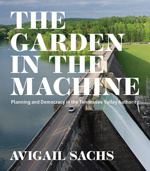Today, we are happy to bring you our conversation with Avigail Sachs, author of The Garden in the Machine: Planning and Democracy in the Tennessee Valley Authority.
What inspired you to write this book?
The landscape of the Tennessee Valley. As a transplant to East Tennessee, I spent time exploring my new region and was fascinated by its unusual combination of natural and human-made features. As I learned more I realized that this landscape represented an outstanding effort by the Tennessee Valley Authority (TVA), including the architects and landscape architects who worked for the federal agency between 1933–53. The designers not only dreamed up a new future—the garden—they also worked creatively within the TVA “machine” in which they enmeshed to find ways to make their dreams into realities. The result is a rich and layered landscape—not without tensions and controversy but still endlessly fascinating.
What did you learn and what are you hoping readers will learn from your book?
My students in the College of Architecture and Design at the University of Tennessee, Knoxville, were a second inspiration for this book. I am consistently in awe of their dreams and ambitions, but recognize that we don’t often discuss what it takes to make these into realities. I hope that they (and other readers) will learn that the process of shaping the built environment is a messy one, full of dead ends and disappointments, but also surprises and exhilaration; that dreaming dreams is crucial, but so is the willingness to adapt and refine them and the tenacity to see them to fruition.
What surprised you the most in the process of writing your book?
The extent to which the infrastructure for recreation in the region—state parks, marinas and docks, trails and cabins—was the product of the landscape architects’ and architects’ ability to combine their vision with the realities of the TVA. Before writing the book I took this infrastructure for granted, a natural byproduct of the larger engineering project. Following the efforts of the landscape architects and architects (what I call the “Atelier TVA” in the book) revealed new, and surprising, dimensions. This development and its long-term impact is the focus of the last chapter of the book.
What’s your favorite anecdote from your book?
Though the book highlights the flexibility that the “Atelier TVA” displayed, my favorite anecdote is actually the product of dogged tenacity. During the construction of Fontana Dam, the tallest dam in the TVA system, landscape architect Osborne H. Graves and architect Mario Bianculli visited the construction site to prepare drawings for its future reclamation. Graves remembered Bianculli, who was very proud of his sketching ability, working on such drawings even as debris from the blasting fell around them. Bianculli was so intent on his vision that he was able to ignore adverse physical conditions. His drawings are indeed amazing, and I included several of them in the book.
What’s next?
It is now time to make a dent in my “to read” pile. There are so many new (and old) books that I have put off reading in order to write. I am looking forward to settling in with other authors and their ideas, snug in a cabin in the Tennessee Valley whenever possible!





